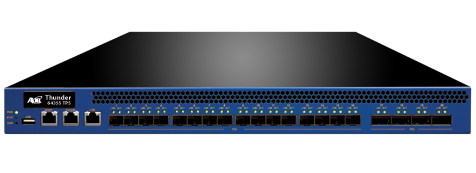A10 Networks, a company that makes application networking products, has launched a new line of standalone, high performance Distributed Denial of Service (DDoS) protection appliances targeted to service providers and large enterprises.
The company, which in Oct. 2013 secured $115 million in capital through an equity financing and a revolving credit facility, this month announced the A10 Thunder TPS Series, appliances designed to provide high-performance, network-wide protection against a variety of volumetric, protocol, resource and other sophisticated DDoS attacks.
A10, which has been a player in the Application Delivery Controller (ADC) market, has been selling DDoS, web application and DNS firewall, SSL intercept and authentication features as part of its ADC product line. Now, the company is offering a line of standalone security appliances dedicated solely to defending large-scale DDoS attacks.
 Launch of a standalone DDoS protection appliance line puts A10 in direct competition with other vendors such as Arbor Networks, Radware, Corero Network Security and NSFOCUS, among others.
Launch of a standalone DDoS protection appliance line puts A10 in direct competition with other vendors such as Arbor Networks, Radware, Corero Network Security and NSFOCUS, among others.
Starting at $195,995, A10’s Thunder TPS appliances are designed to provide protection against large-scale attacks, and support DDoS mitigation capacity ranging from 38 Gbps to 155 Gbps (and up to 1.2 Tbps in a cluster) throughput, according to the company.
Inside each Thunder TPS appliance sits a high-performance FPGA-based Flexible Traffic Acceleration (FTA) technology that is used to detect and mitigate over 30 common attack vectors in hardware, without degrading the performance of the core system general purpose CPUs.
The platform leverages Intel Xeon CPUs to process and detect application layer attacks (layer 7), allowing the system to distribute detection and mitigation functions across optimal system resources, the company explained.
An open design architecture allows the appliances to be deployed into a variety of existing network architectures and integrated with third-party attack detection systems. Thunder TPS supports flexible deployment models for in- and out-of-band operations, and routed or transparent operation modes, A10 said. Additionally, aXAPI, an open RESTful API, enables integration to custom or third-party detection solutions.
“Ixia partnered with A10 Networks to help validate Thunder TPS performance and its many DDoS mitigation options, verifying that it can operate at very high scale using our PerfectStorm security test solution,” said Fred Kost, vice president of security solutions marketing at Ixia. “Since DDoS is a scale-based threat, it is critical that DDoS solutions have the ability to handle both high volume and sophisticated application attacks, protecting network infrastructure and application services from being overwhelmed.”
For the curious, Ixia’s testing solution was gained from it’s 2012 acquisition of BreakingPoint Systems, a maker of technology that helps test IT infrastructure to massive scales and simulate cyberwar conditions.
The three models scheduled to be available in Q1 2014 include:
| Thunder 4435 TPS | Thunder 5435 TPSS | Thunder 6435 TPS |
|
• 38 Gbps • Single Xeon (10 cores) • 16×10/1G ports • 4435S model w/ SSL HW |
• 77 Gbps • Single Xeon (10 cores) • 16×10/1G + 4x40G (32x10G w/breakout) • 5435S model w/ SSL HW |
• 155 Gbps • Dual Xeon (20 cores) • 16×10/1G + 4x40G (32x10G w/breakout) • 5435S model w/ SSL HW |
“DDoS attacks like SYN Flood and Fragmentation attacks are rapidly evolving to becoming a big numbers game, with malicious bots or zombie machines directing massive amounts of traffic in unison toward target victims. Effective DDoS solutions must be able to mitigate at equally massive scale and performance to prevent service interruption,” said Lee Chen, A10 CEO and founder.















